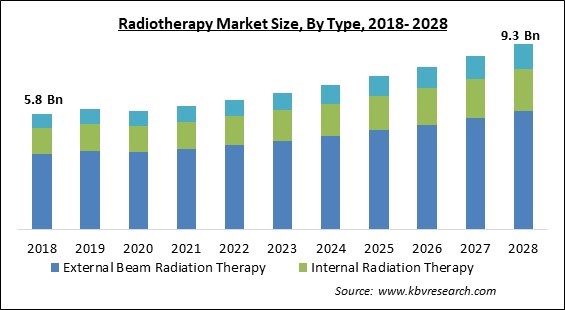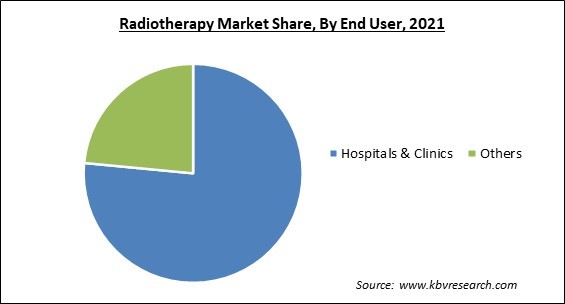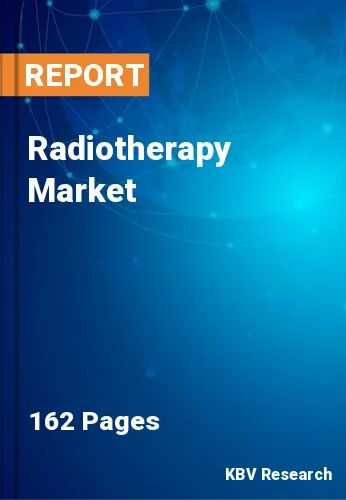The Global Radiotherapy Market size is expected to reach $9.3 billion by 2028, rising at a market growth of 6.1% CAGR during the forecast period.
Radiotherapy, also called radiation therapy, is a cancer treatment process used for cancer patients in which, cancer cells are destroyed while on the other hand, the size of tumors gets reduced in order t cure cancer in the body of the patient. During radiation, gamma rays, X-rays, and charged particles are often utilized in radiotherapy. Radiation therapy damages cancer cells' DNA, which either kills them or limits their growth at high dosages. Cancer cells that have DNA damage that cannot be repaired either cease proliferating or die.

When the injured cells expire, the body degrades and eliminates them. Radiation therapy does not instantly eradicate cancer cells. Before DNA is sufficiently damaged to cause cancer, it may take days or weeks of treatment. The advantages of radiation therapy vary depending on the type of cancer, whether or not it has spread, and how much. Radiation therapy can be administered on its own or as a component of a comprehensive treatment strategy. Radiation therapy is used, among other things, as the main form of cancer treatment or to treat the disease's symptoms.
Typically, cells expand and divide to create new ones. But compared to most normal cells, cancer cells grow and divide more rapidly. Small snags in the DNA of cells are created by radiation as it functions. These fractures stop the growth and division of cancer cells and ultimately lead to their demise. Radiation can also damage nearby normal cells, but most of them recover and resume their regular functions. Radiation therapy is often a local treatment, in contrast to chemotherapy and other cancer-fighting medications that are taken orally or administered intravenously and typically expose the entire body.
This indicates that it is often directed towards and only has an impact on the affected area of the body. Radiation therapies are designed to kill cancer cells while causing the least amount of harm to neighboring healthy cells. Radioactive chemicals are sometimes administered orally or intravenously as part of radiation therapy (systemic radiation therapy). Even though this sort of radiation does penetrate the entire body, the radioactive material mainly gathers in the vicinity of the tumor, leaving the rest of the body with little impact.
Every part of the medical equipment business, including radiation devices, has been impacted by the COVID-19 pandemic. The COVID-19 pandemic has resulted in significant variance in how radiation procedures are managed. As governments, as well as authorities, work to ensure that resources are available for COVID-19 patients, this can be attributed to the interim delay of a number of elective procedures. In order to ease the burden on the healthcare system, reduce disease transmission, and preserve personal protective equipment, several governments have set recommendations for certain elective procedures. Moreover, lockdowns were implemented to stop the COVID-19 virus from spreading. Consequently, COVID-19 has a detrimental impact on the radiotherapy market.
The market for radiotherapy has witnessed significant technological developments in recent years. These developments have contributed to the creation of more efficient, affordable, and simple-to-use radiotherapy systems that deliver radiation doses more precisely and effectively, making it easier to target malignancies. The transition from 2D to 3D volumetric radiotherapy with real-time imaging has made it possible to increase the dose with better tumor control while maintaining high radiation conformance to the target (with little exposure to normal tissue). Products that offer these advantages are anticipated to have very rapid development potential, particularly in developed economies where the rate of adoption of cutting-edge technology is high.

One of the major factors that are driving the growth of the market is the increasing number and volume of investments in the healthcare sector by governments of several countries. It is anticipated that access to high-quality healthcare will improve in several emerging nations due to their rapid economic expansion and rising health expenditures. This is considered to be a positive indicator of development for the radiotherapy market. The demand for various radiation equipment and treatments is increasing as a result of the rising cancer prevalence in these nations. Additionally, governments in each of these nations are focusing on expanding access to high-quality healthcare services for more of their citizens as well as expanding the scope of reimbursement.
A significant issue that needs to be addressed is the side effects that are caused by radiotherapy. The ability to accomplish certain activities may be restricted by side effects. Depending on how a patient feels, they can choose what to do. While receiving radiation therapy, some patients are able to work full time or engage in recreational activities while others discover that they cannot do as much and need more rest than normal. The doctor may shorten the duration of treatments, alter the schedule, or switch the sort of treatment a patient is receiving if they experience side effects that are irritating and negatively impact their daily activities or health.
Based on the Type, the Radiotherapy Market is segmented into External Beam Radiation Therapy, Internal Radiation Therapy, and Systemic Radiation Therapy. In 2021, the external beam segment procured the largest revenue share of the radiotherapy market. The growth of the segment is rapidly rising due to the accuracy of the direct beams at the cancerous cells, which results in less damage to normal tissues and permits oncologists to use higher doses of radiotherapy for treatment and an increase in the cancer population.
By the End-User, the Radiotherapy Market is bifurcated into Hospitals and Clinics and Others. In 2021, the others segment witnessed a substantial revenue share of the radiotherapy market. The rising growth of the segment is owing to the rising burden on hospitals and clinics all over the world due to the COVID-19 pandemic. Owing to this, the demand for ambulatory services and settings is rising.
| Report Attribute | Details |
|---|---|
| Market size value in 2021 | USD 6.2 Billion |
| Market size forecast in 2028 | USD 9.3 Billion |
| Base Year | 2021 |
| Historical Period | 2018 to 2020 |
| Forecast Period | 2022 to 2028 |
| Revenue Growth Rate | CAGR of 41.5% from 2022 to 2028 |
| Number of Pages | 217 |
| Number of Tables | 400 |
| Report coverage | Market Trends, Revenue Estimation and Forecast, Segmentation Analysis, Regional and Country Breakdown, Companies Strategic Developments, Company Profiling |
| Segments covered | Type, End User, Region |
| Country scope | US, Canada, Mexico, Germany, UK, France, Russia, Spain, Italy, China, Japan, India, South Korea, Singapore, Malaysia, Brazil, Argentina, UAE, Saudi Arabia, South Africa, Nigeria |
| Growth Drivers |
|
| Restraints |
|
Region-Wise, the Radiotherapy Market is analyzed across North America, Europe, Asia-pacific, and LAMEA. In 2021, North America accounted for the largest revenue share of the radiotherapy market. The growth of the segment is rapidly rising due to the rising incidence of cancer patients, the presence of a significant number of key market players, as well as the advancement of R&D activities within the healthcare sector in the region. Lung cancer is one of the leading causes of death in the region, due to which, the demand for radiotherapy is significantly increasing in the region. This factor is bolstering the growth of the regional radiotherapy market.
Free Valuable Insights: Global Radiotherapy Market size to reach USD 9.3 Billion by 2028
The market research report covers the analysis of key stake holders of the market. Key companies profiled in the report include Becton, Dickinson and Company, Siemens Healthineers AG, Accuray, Incorporated, Elekta AB, Eckert & Ziegler AG, Ion Beam Applications SA, iCAD Inc., Isoray Inc., Mevion Medical Systems, Inc., and Nordion Inc. (Sotera Health LLC).
By End User
By Type
By Geography
The Radiotherapy Market size is projected to reach USD 9.3 billion by 2028.
Technological Advancements In Radiation Therapy are driving the market in coming years, however, Side-Effects Of Radiotherapy restraints the growth of the market.
Becton, Dickinson and Company, Siemens Healthineers AG, Accuray, Incorporated, Elekta AB, Eckert & Ziegler AG, Ion Beam Applications SA, iCAD Inc., Isoray Inc., Mevion Medical Systems, Inc., and Nordion Inc. (Sotera Health LLC).
The expected CAGR of the Radiotherapy Market is 6.1% from 2022 to 2028.
The Hospitals & Clinics segment acquired maximum revenue share in the Global Radiotherapy Market by End User in 2021, thereby, achieving a market value of $6.75 billion by 2028.
The North America market dominated the Global Radiotherapy Market by Region in 2021, and would continue to be a dominant market till 2028; thereby, achieving a market value of $3.55 billion by 2028.
Our team of dedicated experts can provide you with attractive expansion opportunities for your business.

